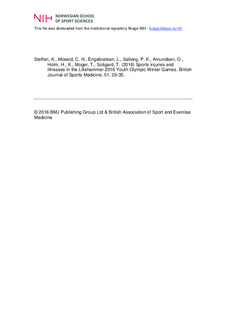| dc.contributor.author | Steffen, Kathrin | |
| dc.contributor.author | Moseid, Christine Holm | |
| dc.contributor.author | Engebretsen, Lars | |
| dc.contributor.author | Sørberg, Pia K. | |
| dc.contributor.author | Amundsen, Olav | |
| dc.contributor.author | Holm, Kristian | |
| dc.contributor.author | Moger, Thomas | |
| dc.contributor.author | Soligard, Torbjørn | |
| dc.date.accessioned | 2016-12-19T14:16:38Z | |
| dc.date.available | 2016-12-19T14:16:38Z | |
| dc.date.issued | 2016-11-24 | |
| dc.identifier.citation | British Journal of Sports Medicine. 2016, 51, 29-35 | nb_NO |
| dc.identifier.uri | http://hdl.handle.net/11250/2425489 | |
| dc.description.abstract | Background: Injury and illness surveillance during high-level youth sports events is an important first step in health prevention and caretaking of the young elite athletes.
Aim: To analyse injuries and illnesses that occurred during the 10 days 2nd Youth Olympic Winter Games (YOG), held in Lillehammer 2016.
Methods: We recorded the daily occurrence (or non-occurrence) of injuries and illnesses through the reporting of (1) all National Olympic Committee (NOC) medical teams and (2) the polyclinic and medical venues by the Lillehammer Organising Committee (LYOCOG) medical staff.
Results: In total, 1083 athletes (48 double-starters), 46% (n=502) of them females, from 70 NOCs were registered in the study. NOCs and LYOCOG reported 108 injuries and 81 illnesses, equalling to 9.5 injuries and 7.2 illnesses per 100 athletes. The percentage of injured athletes was highest in the snowboard and ski slopestyle and cross disciplines, alpine skiing and skeleton, and lowest in the Nordic skiing disciplines. Approximately, two-thirds of the injuries (n=71, 65.7%) prevented the athlete from training or competition, while 10 injuries (9.3%) were registered with an estimated absence from sport for >7 days. The rate of illness was highest in curling and the Nordic skiing disciplines with most of them being respiratory tract infections (81.5%).
Conclusions: Overall, 9% of the athletes incurred at least one injury during the games, and 7% an illness, which is similar to the first YOG in Innsbruck 2012 and slightly lower compared with previous Winter Olympic Games. The incidence of injuries and illnesses varied substantially between sports. | nb_NO |
| dc.language.iso | eng | nb_NO |
| dc.publisher | BMJ | nb_NO |
| dc.subject | athlete | nb_NO |
| dc.subject | illness | nb_NO |
| dc.subject | injuries | nb_NO |
| dc.subject | surveillance | nb_NO |
| dc.subject | young | nb_NO |
| dc.title | Sports injuries and illnesses in the Lillehammer 2016 Youth Olympic Winter Games | nb_NO |
| dc.type | Journal article | nb_NO |
| dc.type | Peer reviewed | nb_NO |
| dc.subject.nsi | VDP::Samfunnsvitenskap: 200::Samfunnsvitenskapelige idrettsfag: 330::Andre idrettsfag: 339 | nb_NO |
| dc.source.journal | British Journal of Sports Medicine | nb_NO |
| dc.identifier.doi | 10.1136/bjsports-2016-096977 | |
| dc.description.localcode | Seksjon for idrettsmedisinske fag / Department of Sports Medicine | nb_NO |
